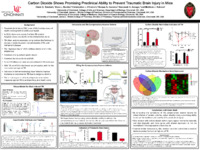Carbon Dioxide Shows Promising Preclinical Ability to Prevent Traumatic Brain Injury in Mice
Main Article Content
Abstract
By Owen Traubert, Neurobiology; Evan Reeder; Christopher O'Connell; Roman Caceres; Savannah Savage
Advisor: Matthew Robinson
Award: Excellence in Research Communication
Presentation ID: 312
Abstract: Traumatic brain injury (TBI) affects millions of people each year and has massive human and economic costs. Particularly prevalent among veterans and contact sport players, TBI can lead to long-term social and cognitive consequences. TBI has numerous modalities of injury, many of which are caused by the propensity of the brain to move within the skull (slosh) during rapid head acceleration-deceleration and rotation. A small amount of "free" space in the skull, the compensatory reserve volume (CRV), allows for acceleration-deceleration injury from the brain impacting the skull and rotational strain. Advances in helmet technology have not reduced slosh because helmets are worn outside of the skull and cannot further reduce forces imparted to it within practical design parameters. Successful preclinical and clinical preventative interventions against TBI, including the first FDA-approved non-helmet preventative device, have implemented slosh mitigation, which "fills" the CRV by maximizing the volume of blood in the skull. The most immediate and significant way of increasing cerebral blood flow and thus volume is increasing the partial pressure of carbon dioxide (CO2) in blood, which immediately dilates cerebral arteries, a property previously unexplored in TBI. We exposed mice to atmospheric air or 5% CO2 atmosphere immediately before subjecting them to TBI or sham treatment. Preliminary results show that pre-trauma CO2 exposure normalizes several behavioral, physiological, and molecular indicators of TBI in mice. Work presented here is the first evidence of a novel mechanism of slosh mitigation to prevent TBI, which could be translated to a medical device for humans.
